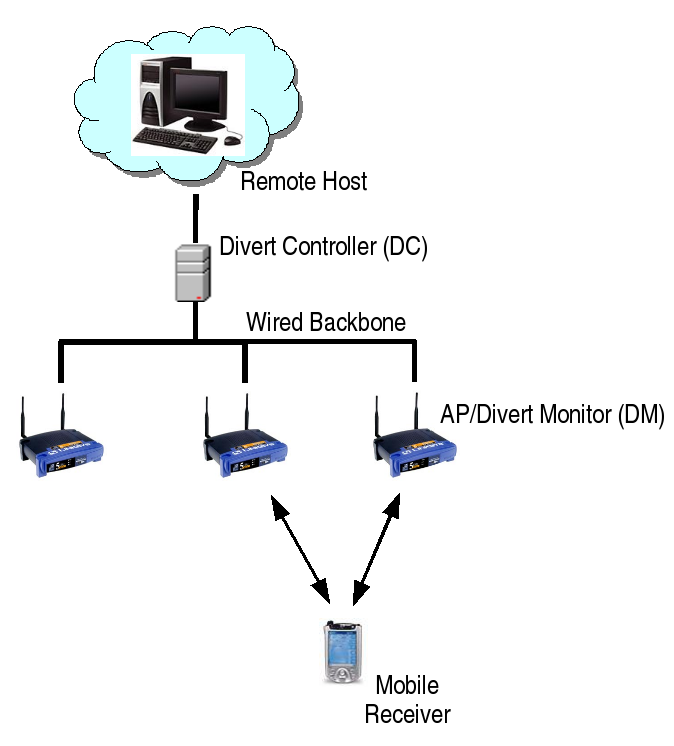

|
- |
what Divert is all about? |
|
|
- |
what is the current project status? |
|
|
- |
Divert documents |
|
|
- |
selected presentation slides |
|
|
- |
selected Divert experimental data |
|
|
- |
other cool wireless research projects |
|
|
- |
who are we? |
|
|
- |
who sponsors Divert? |
|
|
- |
where to send questions or comments? |
Wireless communication channels have notoriously time-varying characteristics, where the quality of received signals changes dramatically even over time durations lasting just milliseconds. The complex behavior of wireless signal propagation, particularly indoors and in presence of mobility, leads to bursty frame corruptions at the link-layer that can last over tens of milliseconds. The detrimental link-layer effects are manifested in the higher layers as packet losses and higher and more variable packet latencies that can severely impact the performance of many applications such as bulk file transfer, telephony, video streaming and other interactive wireless applications.
Through our experiments, we observe that wireless data transmissions are path-dependent and that channel conditions are weakly correlated between different paths in the wireless medium. Motivated by these observations, we design Divert, a system that employs path diversity techniques to reduce frame losses in wireless local area networks (WLAN).
In our current design, an operator of the Divert WLAN deploys wireless access points (AP) in spatially diverse locations to provide a set of alternate transmission paths between a client and the WLAN infrastructure. A Divert Monitor (DM) runs at each AP to monitor the channel condition of the wireless transmission path to a WLAN client and sends feedback to the Divert Controller (DC), which runs a fine-grained path selection algorithm. When the DC detects that the current transmission path is suffering from poor channel conditions, the DC quickly and with little overhead diverts subsequent frame transmissions to an alternate AP. The path selection is fine-grained because it can occur on a frame-by-frame basis to avoid potential burst losses in a path. Although not currently implemented in our system, Divert can also employ other techniques for coping with high frame loss rates such as packet fragmentation, varying packet sizes, forward error correction, and adjusting data transmission rates.

Some research challenges of Divert are:
We have implemented Divert using Linux PCs equipped with standard PRISM II-based 802.11b wireless interfaces. The prototype supports fine-grained path selection in the downlink direction and it works with standard, unmodified 802.11b clients that run in managed mode. Our experimental results show that Divert effectively reduces frame losses--especially for mobile clients--in realistic scenarios without consuming extra bandwidth in the wireless medium.
Our current plan is to implement fine-grained path selection in the uplink direction and also to compare the performance of Divert between 802.11a/b/g WLANs.
Improving Loss Resilience with Multi-Radio Diversity in Wireless
Networks
Allen Miu,
Hari Balakrishnan,
Can Emre Koksal
Proc. of 11th ACM
MobiCom,
Cologne, Germany, August, 2005. (Best Paper Candidate)
Divert: Fine-grained Path Selection for Wireless LANs
Allen Miu,
Godfrey Tan,
Hari Balakrishnan,
John
Apostolopoulos
Proc. of 2nd ACM
MobiSys,
Boston, MA, June 2004, pp. 203-216.
Low-Latency Wireless Video Over 802.11 Networks Using Path Diversity
Allen Miu,
John
Apostolopoulos,
Wai-tian Tan, Mitchell Trott
Proc. of
IEEE ICME,
Baltimore, MD, July 2003, vol. 2, pp. 441-444.
Traces from our Mobisys 2004 paper.
Please also see papers for additional useful references.
We gratefully acknowledge funding for Divert from Acer Inc., Delta Electronics Inc., HP Corp., NTT Corp., Nokia Research Center, and Philips Research under the MIT Project Oxygen partnership, and from Intel Corporation.
Please send all questions and comments to Allen Miu at aklmiu{at}mit{dot}edu.
NMS @ MIT CSAIL MMSL @ HP Labs
M. I. T. Computer Science and Artificial Intelligence Laboratory · The Stata Center · 32 Vassar Street · Cambridge, MA 02139 · USA